This post may include affiliate links; see our disclosure policy.
Here’s how to make espresso at home like a pro! From machine to French press, here are five simple ways to brew rich, bold espresso flavor.
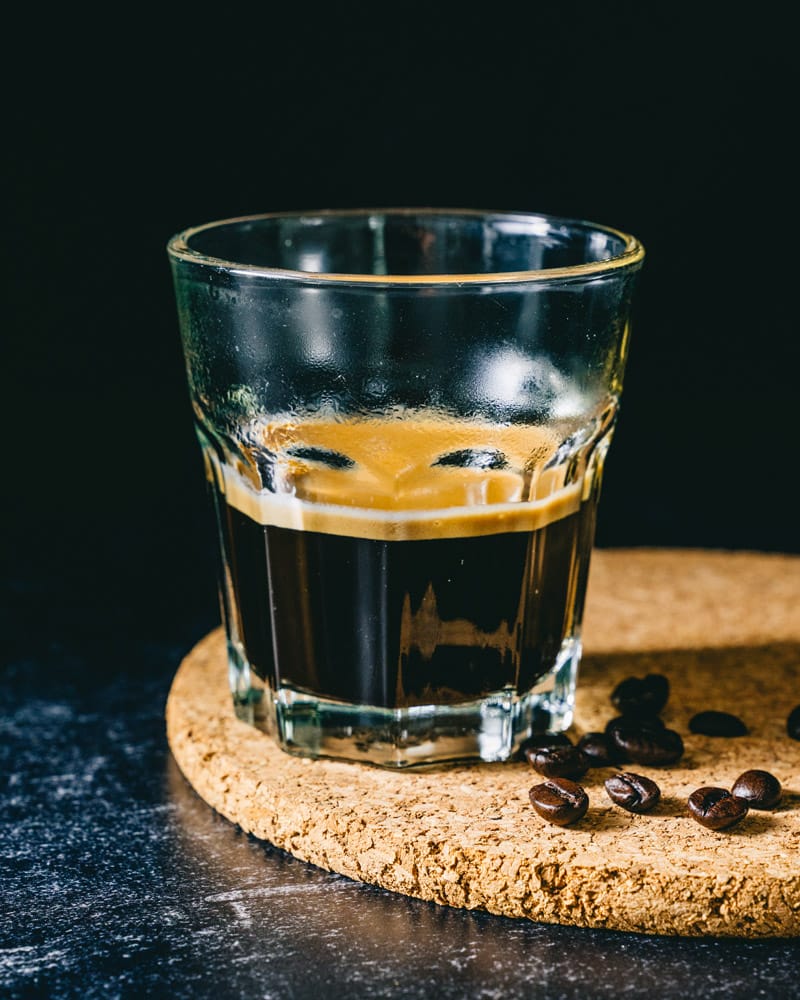
When it comes to coffee, to me there’s nothing better than a bitter, rich espresso shot with a layer of foamy crema. Not only is it delicious on its own, you can make a whole host of espresso drinks like a good latte, cappuccino, flat white, and macchiato,.
Turns out, making espresso is more approachable than you think! As a homemade coffee lover, I’ve tested all the main brew methods and I’m sharing everything I’ve learned. From traditional espresso machines to French press techniques, Moka pots, and even portable options, there’s a method that works for your budget, kitchen space, and skill level.
Why You’ll Love This Espresso
Making espresso at home has completely changed my morning routine, and here’s why I think you’ll love it too:
- No fancy setup required: While an espresso machine makes excellent shots, I’ve tested multiple ways to brew espresso without one.
- Incredible flavor: Once you can make a shot of espresso at home, you can create rich and delicious lattes and Americanos for a fraction of what cafes charge.
- Tested methods with honest feedback: I’m giving you my real assessment of each brew method, including pros, cons, and which situations each one works best for.
What Is Espresso?
Espresso is an Italian way of making coffee in highly concentrated shots. A single espresso shot is 1 ounce, and a double shot is 2 ounces.
Espresso can be sipped in small cups, or used as the base for popular espresso drinks like the Americano, latte, cappuccino, and more. To make espresso, water is forced through finely ground coffee beans at very high pressure. A espresso shot has crema on top: a light brown foam that adds a rich flavor and frothy texture.
Equipment & Tools You’ll Need
How to make espresso at home? If you want top quality espresso, a countertop espresso machine is where it’s at. The flavor is better than any method you’ll find! But there are a few other methods that can approximate a great espresso. Here’s an overview of the equipment you’ll need for each espresso method:
- Espresso machine: You’ll need a countertop espresso machine with built-in burr grinder, as well as a portafilter and tamper. A knock box is helpful for tamping and discarding grounds.
- Portable espresso maker: A portable espresso maker simplifies the process.
- French press: You’ll need a French press coffee maker, an electric burr grinder, and a food scale. An electric tea kettle is helpful for boiling the water.
- Moka pot: You’ll need a Moka Pot like this 6 Cup Bialetti Moka Pot (the one I use), electric burr grinder, and a food scale.
- Aeropress : You’ll need an Aeropress, electric burr grinder, and food scale. An electric tea kettle is also helpful.
Choosing Your Coffee Beans
The type of coffee beans you use makes a huge difference in the final cup. Here’s what I’ve learned about selecting the best coffee for home espresso:
- Roast: Look for espresso roast or dark roast coffee for the most bold, classic flavor.
- Freshness: Buy whole beans and grind them right before brewing. Pre-ground coffee loses its flavor quickly. If possible, buy from a local roaster and check the roast date. I try to use beans within 2-4 weeks of roasting.
- Grind: For espresso, you need fine, even particles. A quality burr grinder is worth the investment if you’re serious about great espresso, or use the one built into your espresso machine).
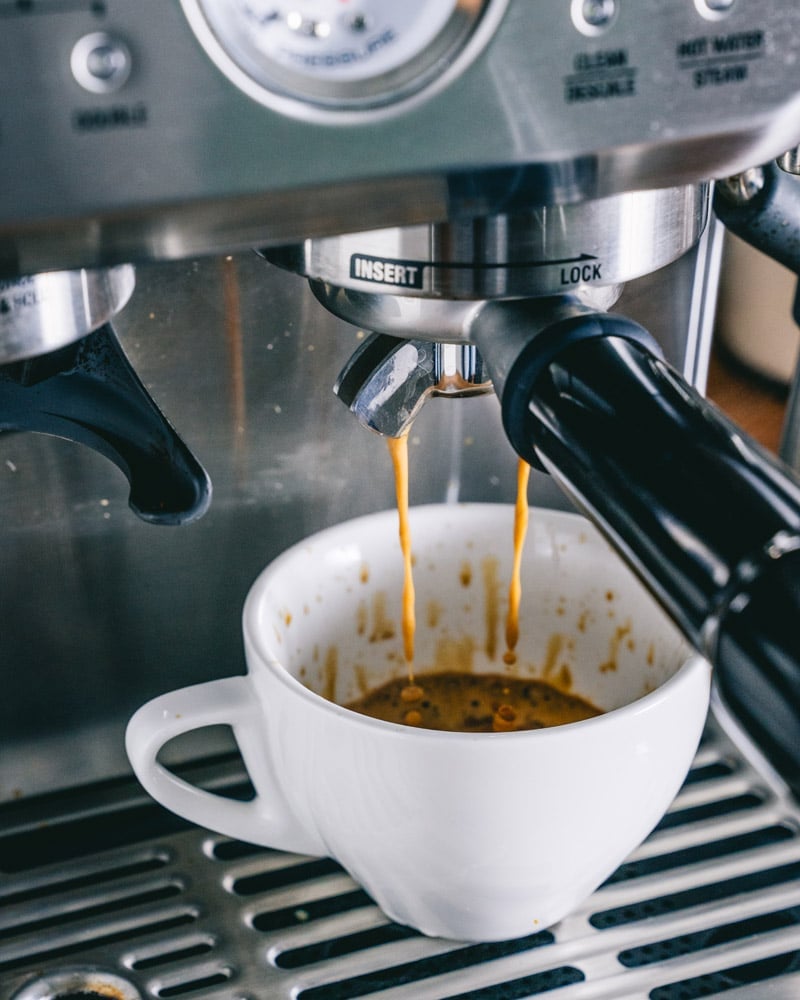
How to Make Espresso at Home: 5 Methods
Method 1: Espresso Machine
The best way to make espresso? With an espresso machine! Here’s what to know:
A countertop espresso machine makes the best tasting espresso. It tastes even as good as a coffeeshop, with a rich layer of crema. This type of machine is similar to what you’d see a barista use: it sits on the countertop and grinds the coffee. Many espresso makers also have a steaming wand to make steamed milk for lattes and cappuccinos.
Pros and cons: Countertop espresso machines are the priciest option, starting about $300 to several thousand dollars. But if you’re a purist, it’s worth it for the high quality! This is the best choice for a coffee connoisseur who wants a premium in-home espresso experience.
Product recommendation: Here’s my Breville espresso machine: it works wonderfully and makes the best espresso I’ve had outside of Italy. It’s spoiled me because it’s better than most American coffeeshops. It’s pricey, but worth it for a coffee nerd like me.
Accessories: Make sure to get a knock box to use with your espresso machine. It’s helpful for tamping and discarding the used coffee grounds.
How to do it: See the section below.
How to make espresso with an espresso machine
- Grind the coffee: Use espresso roast coffee, about 9 grams for a single espresso shot and 18 grams for a double shot. Grind the coffee until it’s very fine ground. Different roasts and brands of beans will require a different grind for your machine. You may need to do a few test runs to get it dialed in just right.
- Pack and tamp the coffee grounds: Add the coffee grounds to the espresso basket (portafilter) until it’s slightly heaping over the top. Use the tamper to press the grounds evenly into the portafilter, pressing very firmly until it is fully compressed. Place the portafilter on a folded towel before tamping, or the best tool is a knock box for tamping and discarding used grounds. It’s important for the coffee grounds to be as even and straight as possible to get the best espresso shot.
- Pull the shot: Place the portafilter in the espresso machine and press the button to pull the shot. Most home espresso machines have an automatic option for this. A well-pulled espresso shot will last around 25 to 30 seconds and have deep espresso flavor with a nice foamy crema.
- Consider any adjustments: It takes a while to dial in the fineness of the coffee grind and amount of coffee to use: practice makes perfect! If the shot is watery, use slightly more coffee grounds or a finer grind on the coffee. If a shot takes longer than 30 seconds, reduce the amount of coffee grounds or use a coarser grind on the coffee.
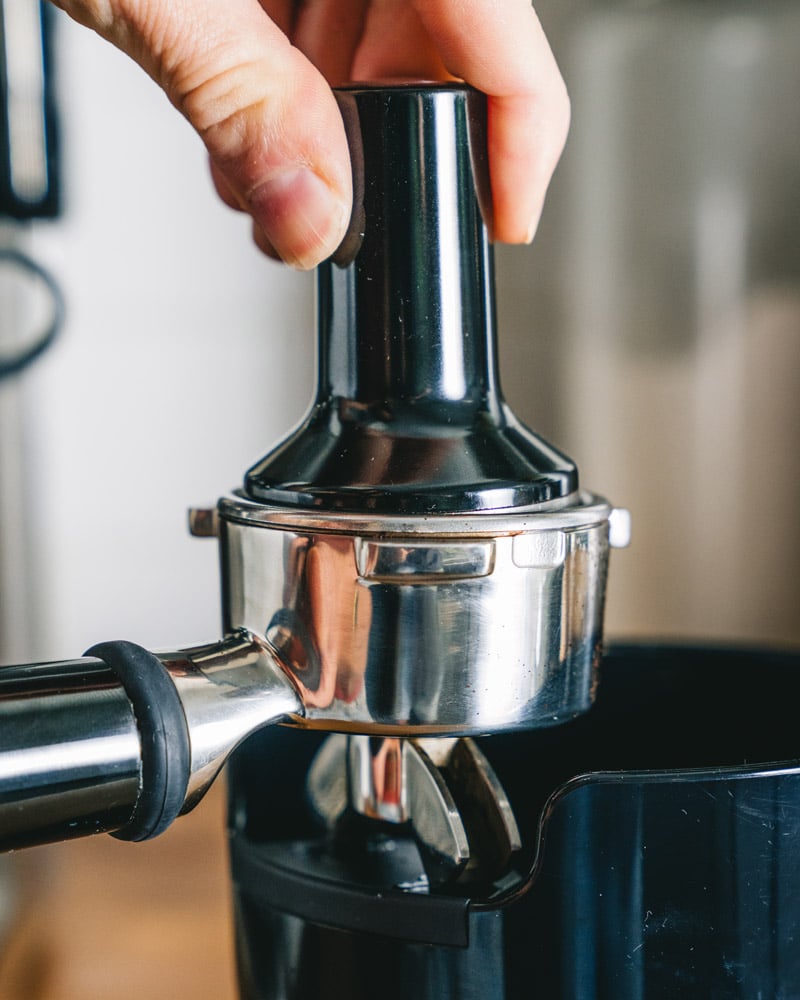
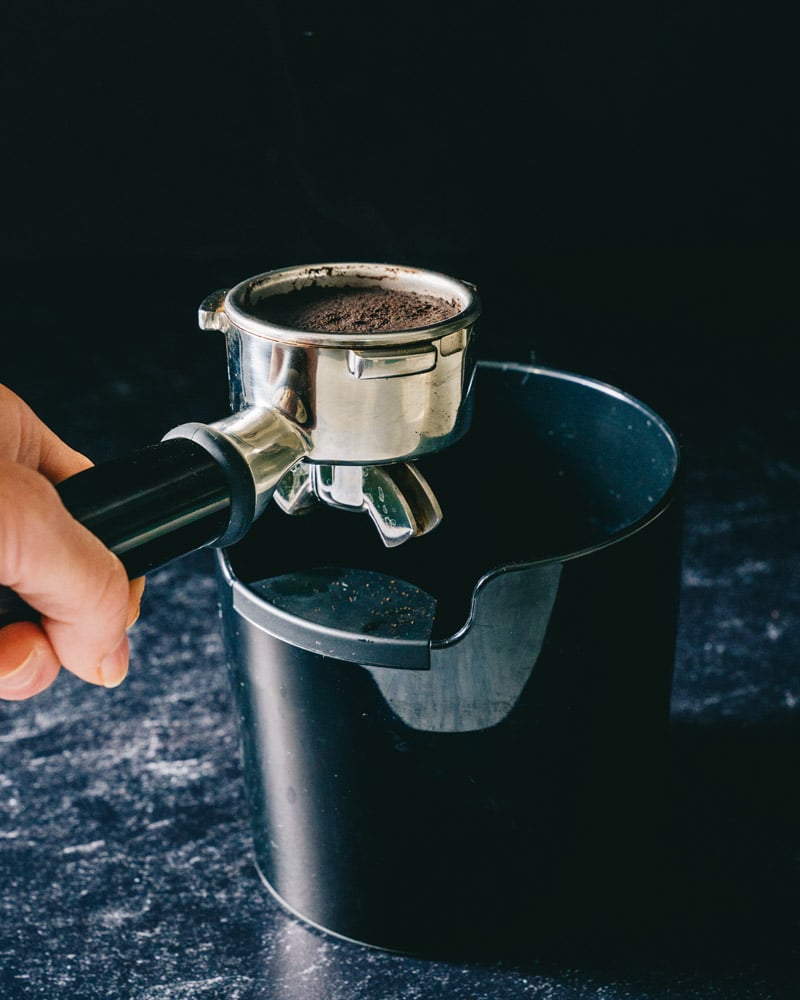
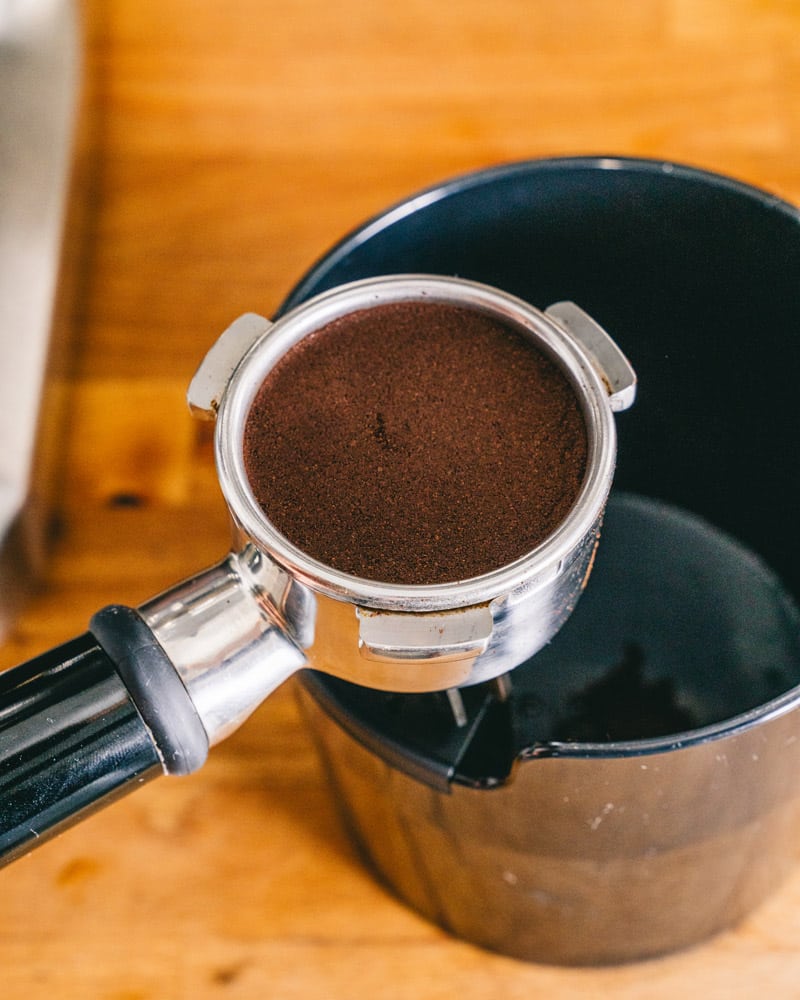
Method 2: Portable Espresso Maker
My second choice is much cheaper, but close to the espresso machine in quality: a manual portable espresso maker! Here’s what it is:
- A portable espresso maker is the best way to make espresso without a machine. This small device lets you manually push the water through the coffee into the cup. It’s small, portable, and easy to use for traveling or to take to an office.
- Pros and cons: The portable espresso maker makes slightly less quality espresso than the espresso machine: the flavor isn’t quite as tasty and the crema not as rich and abundant. But the flavor is surprisingly decent and at $65, it’s a steal! It’s also small and easy to hide away in cabinets or take traveling.
- Product recommendation: I use this portable espresso maker and it works great.
- How to do it: Follow the package instructions for how to use this device.
Method 3: French Press Espresso
The French press is a great way to make espresso: and it’s perfect if you already have one! This is my top choice for how to make espresso without a specific tool, because the flavor is pretty comparable to the real thing.
- A French press is a device for brewing coffee in a small pitcher. It’s most often used for brewed coffee, but it works for espresso too.
- Pros and cons: The French press can’t achieve a foamy crema like the first two espresso making methods, and you do end up with some sediment in your cup. But for a brewed coffee method, it gets pretty close to the flavor of a true espresso. It’s great for making espresso for coffee drinks or an affogato. Most French presses cost about $35 to $40, and you can use them for brewed coffee as well.
- Product recommendation: This
Bodum French press is a high quality option. - How to do it: Go to How to Make French Press Espresso.
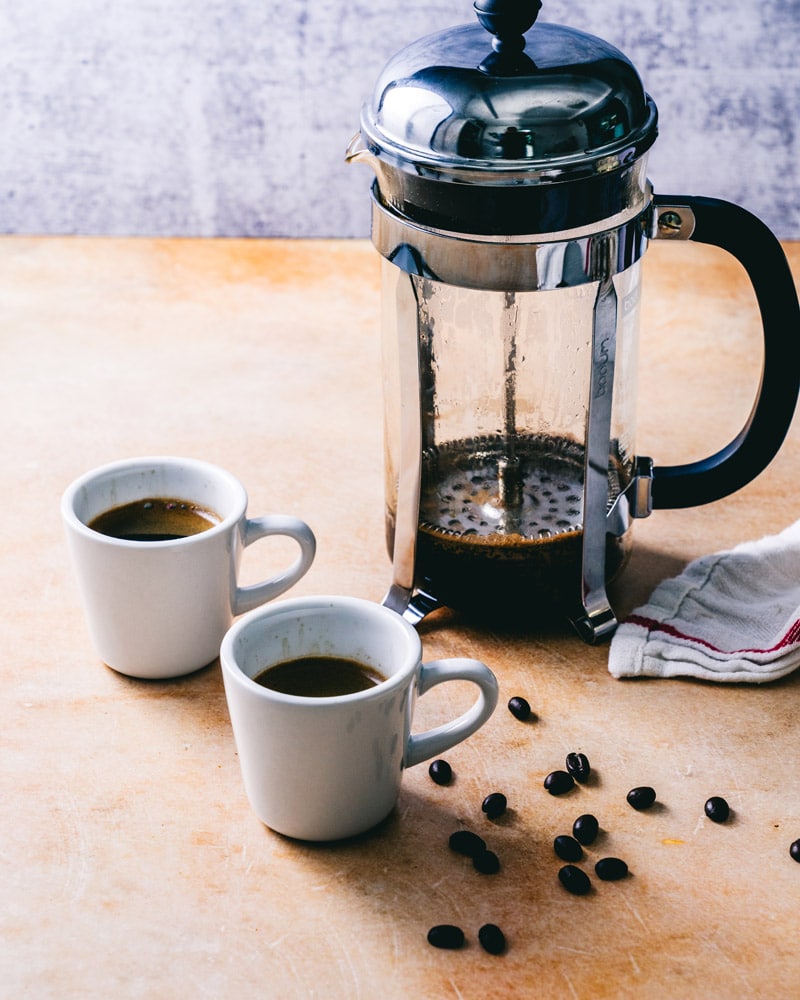
Method 4: Moka Pot
The Moka Pot is a great way to achieve a dark, rich flavored coffee. It’s not quite espresso, but it tastes so similar you can use it as a stand-in for espresso drinks. It’s more like an Americano than espresso. The Moka Pot is also known as a Bialetti, which is the brand name.
- The Moka Pot is a stovetop method for making strong coffee by forcing steam through coffee grounds. It makes a deliciously rich pot of coffee, and is popular in Europe and the US.
- Pros and cons: The flavor you can achieve with a Moka Pot is fantastic. It’s actually very strong dark roast coffee, not technically espresso: so it doesn’t achieve a crema and lacks some of the richness in flavor. It makes a cup that is 5 ounces, whereas a single espresso shot is 1 ounce and a double shot is 2 ounces. But it works well as an option for espresso drinks! At $35 for one pot, it’s a steal.
- Product recommendation: Here’s the 6 cup Moka Pot we use.
- How to do it: Go to How to Use a Moka Pot.
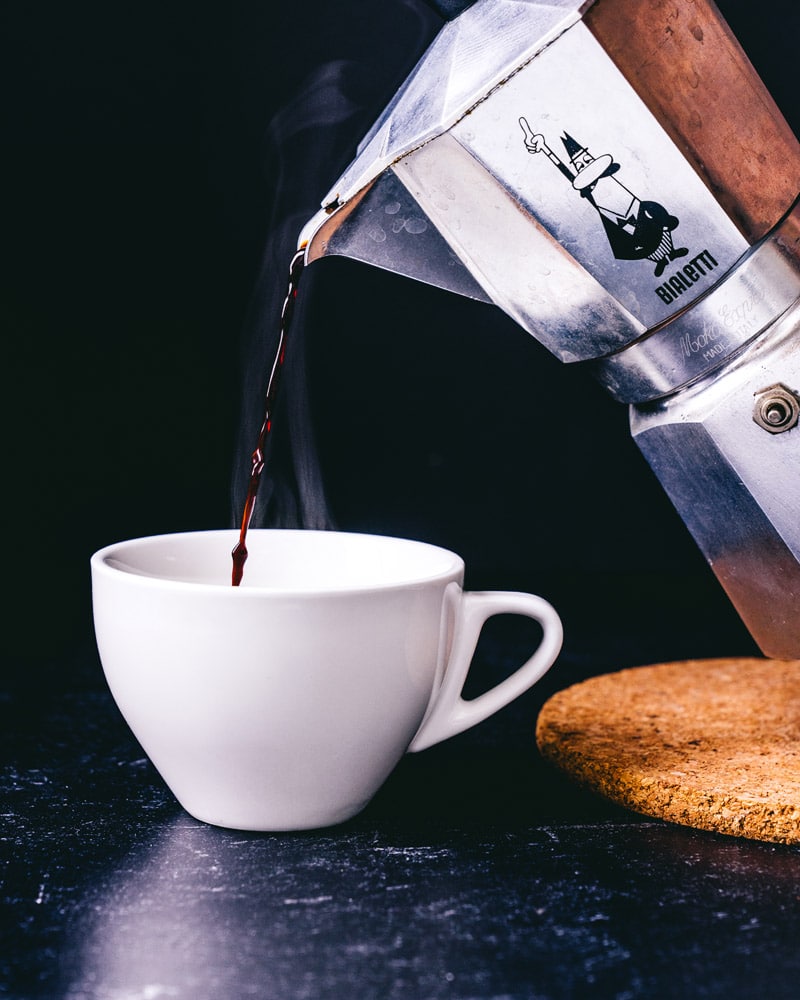
Method 5: Aeropress Espresso
You can make espresso with an Aeropress, but it’s not my top choice for flavor. Only use this if it’s the only option you have on hand!
- An Aeropress is a plastic cylinder used to make a single cup of coffee. It’s portable, cheap and easy to clean, making it an accessible way to make coffee.
- Pros and cons: The Aeropress is very cheap at $30. But this method makes major sacrifices on flavor. Aeropress espresso tastes more bitter and flat than other methods, and has no signature crema. Only use this method if it’s your last resort.
- Product recommendation: Here’s the 1 to 3 cup Aeropress we use.
- How to do it: Go to How to Make Aeropress Espresso.
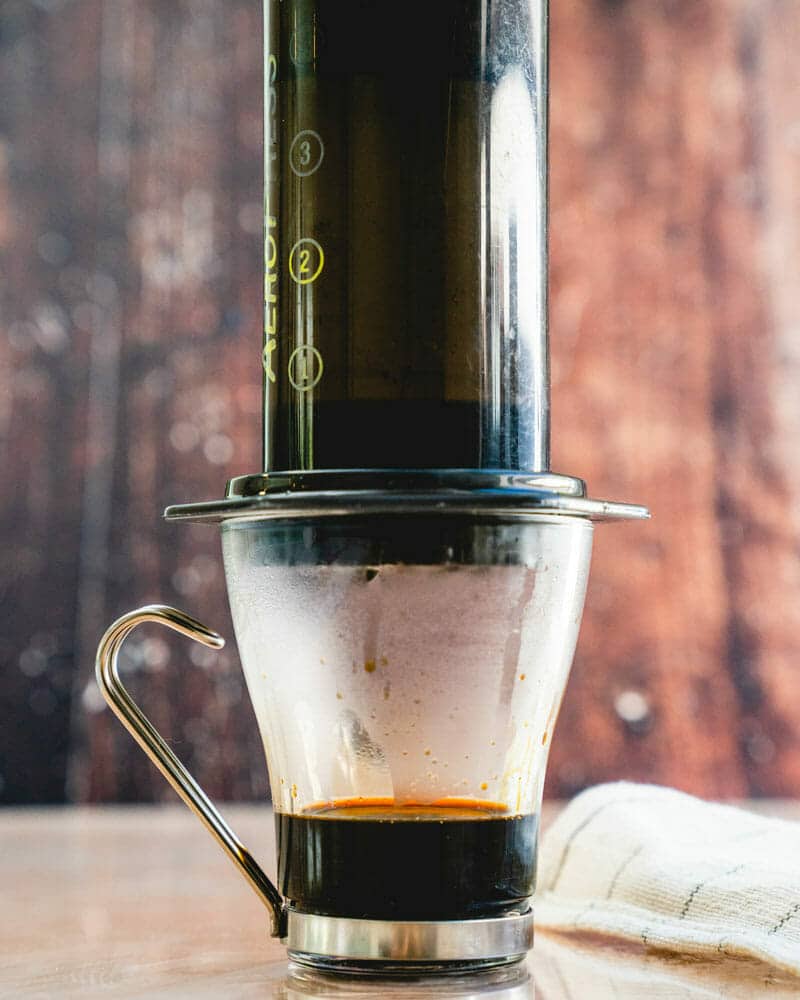
Frequently Asked Questions
Yes! While “espresso roast” beans are specifically roasted for espresso, you can use any coffee beans. However, I recommend sticking with a dark roast coffee. Light roasts can taste sour or overly acidic when brewed as espresso due to the intense extraction process. The key is grinding your beans very fine, regardless of what roast level you choose.
For a Moka pot, use medium-fine ground coffee: somewhere between espresso grind and drip coffee grind. Dark roasts are traditional in Italian households and produce that classic bold, slightly bitter flavor that’s characteristic of espresso. Avoid light roasts as they can taste too acidic.
A single shot of espresso is 1 ounce (about 30 ml), and a double shot is 2 ounces (about 60 ml). Most coffee shops and home baristas default to pulling double shots since they’re more balanced in flavor. When using an espresso machine, a double shot typically uses 18-20 grams of ground coffee to produce that 2-ounce serving.
To make a cappuccino at home, start by pulling a double shot of espresso (2 ounces). Then steam 4 ounces of milk until it’s frothy and has a good amount of microfoam. Pour the steamed milk over the espresso shot, and you’ll have a classic cappuccino with a 1:2 ratio of espresso to milk. The key is getting that thick, velvety foam: which requires a steam wand or milk frother.
How to Make Espresso at Home
Here’s how to make espresso at home! Make 1 or 2 espresso shots with an espresso machine, or opt for one of the listed alternate methods.
- Prep Time: 5 minutes
- Cook Time: 0 minutes
- Total Time: 5 minutes
- Yield: 1 single shot or double shot espresso 1x
- Category: Drink
- Method: Espresso machine
- Cuisine: Coffee
- Diet: Vegan
Ingredients
- 9 grams espresso roast coffee for single shot, 18 grams for a double shot
- Espresso machine (or see alternative methods in the note below!)
- Knock box
Instructions
*Note: The method below works for all countertop espresso machines. Or follow these alternative methods: 1. Use a Portable Espresso Maker per the package instructions. 2. Make French Press Espresso 3. Make Moka Pot Coffee. 4. Make Aeropress Espresso.
- Grind the coffee: Grind the coffee until it’s very fine ground. Different roasts and brands of beans will require a different grind for your machine. You may need to do a few test runs to get it dialed in just right.
- Pack and tamp the coffee grounds: Add the coffee grounds to the espresso basket (portafilter) until it’s slightly heaping over the top. Use the tamper to press the grounds evenly into the portafilter, pressing very firmly until it is fully compressed. It’s useful to have something to press onto for tamping so that you don’t damage the counter or filter. Place the portafilter on a folded towel before tamping, or the best tool is the ledge of a knock box (you can also use it to discard the used grounds). It’s important for the coffee grounds to be as even and straight as possible to get the best espresso shot.
- Pull the shot: Place the portafilter in the espresso machine and press the button to pull the shot. Most home espresso machines have an automatic option for this. A well-pulled shot will last around 25 to 30 seconds and have deep espresso flavor with a nice crema (foamy topping).
- Consider any adjustments: It takes a while to hone in the grind of the coffee and the tamping process. Don’t worry if it’s not exactly right the first time! If you find that the shot is watery, use slightly more coffee grounds or use a finer grind on the coffee. If the shot takes longer than 30 seconds, reduce the amount of coffee grounds or use a coarser grind on the coffee.
Notes
Freshness: Use coffee beans within 2-4 weeks of the roast date for best results. Pre-ground coffee will never produce the same quality.
Temperature: Most machines maintain 195-205°F automatically. If your espresso tastes sour, your water may be too cool. Bitter espresso can mean water that’s too hot.
Alternative Methods: Don’t have an espresso machine? Try the portable espresso maker method, French press espresso, or Moka pot for different approaches that don’t require expensive equipment.
Making Multiple Drinks: If making lattes or cappuccinos for multiple people, pull shots in succession and start steaming milk after your second shot.




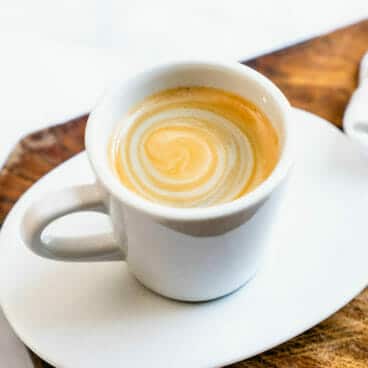
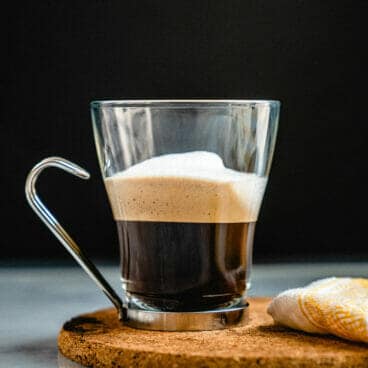

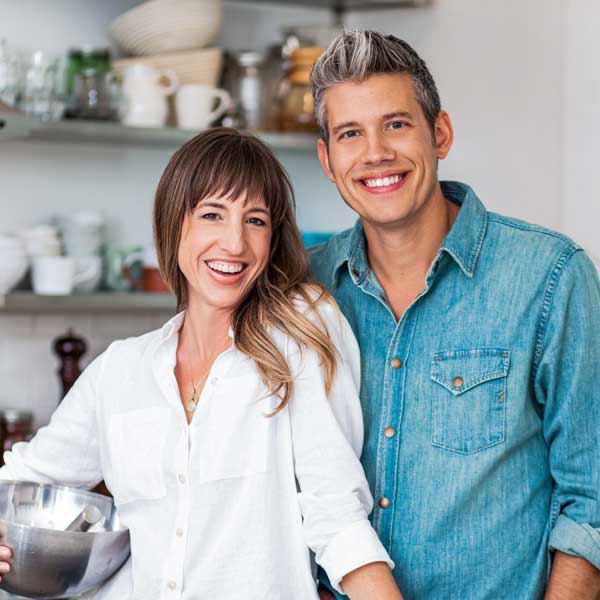

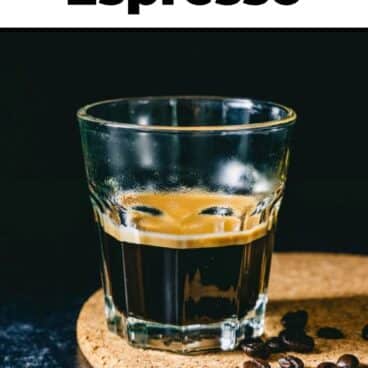
How much water to put in? I didn’t see that info
Hi! A single shot of espresso results in one ounce, but you generally put more in your espresso machine.
I think this web site has got some rattling good info for everyone :D. “As ill-luck would have it.” by Miguel de Cervantes.
Let us know if you have any questions!